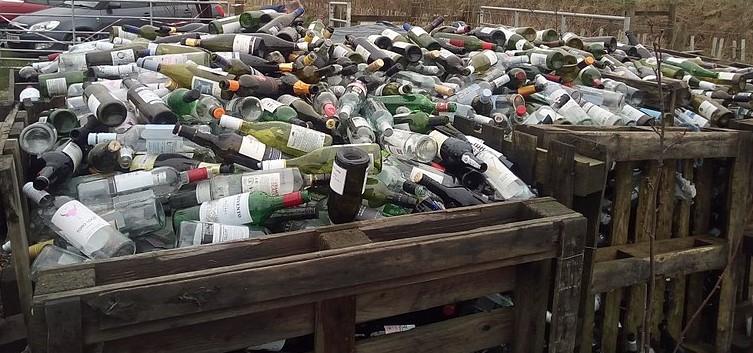Glass bottle foundation

|
| These bottles were used as insulation for the Round House floor at Whistlewood Common in Melbourne, Derby, United Kingdom. |
Contents |
[edit] Introduction
Glass bottles can be used as part of a sturdy foundation to trap a layer of air between the ground and the finished top surface. This creates a layer that is naturally insulated and waterproof. It is also well protected from rats and other pests that could otherwise tunnel under the floor.
This is not a new method of construction. Like other methods of construction that used glass, glass bottle floor foundations are well documented from Victorian times. More recently, glass bottle flooring foundations have experienced a spike in interest due to their effective reuse of glass bottles. The method is also popular for self-build projects when DIYers are looking for alternative waste reduction options.
There are two basic methods of creating a glass bottle floor foundation.
[edit] Bottles and sand
For this method, the rough earthwork is first layered with sand, gravel or other loose, natural material. The unbroken glass bottles are then placed in neat rows either nose down or side by side in alternating directions on top of the rough earthwork. This is then covered with another layer of sand over the bottles.
Next, a layer of protective sheeting is used to cover the sand. This layer can be something as simple as plastic sheeting or another material (such as a geotextile membrane or a different form of damp-proof membrane). The purpose of this layer is to help prevent moisture from coming up from the ground.
Finally, concrete or a similar substance is poured over the protective layer to create a floor that is strong and protected from cold and damp.
[edit] Method two: bottles and concrete
Another method of construction is to place a layer of wet concrete on the rough earth and then position the bottles side by side on top of the concrete. The bottles should not touch - there should be a small gap between each bottle. The bottles are then pressed down gently into the wet concrete.
A second layer of wet concrete is then spread over the first layer and the bottles. The top layer of concrete should be pressed between the bottles with another layer of concrete on top. Another layer of side by side glass bottles is added - this time staggered over the first layer.
This method continues until the floor has reached the desired height. The final layer should be at least two inches thick to provide optimum strength.
Empty glass bottles are strong enough to withstand sand or concrete being placed around them. The reused glass bottles trap air and create an air pocket in the concrete which helps keep the floor insulated from cold that would otherwise come up from the ground.
[edit] Related articles on Designing Buildings Wiki
Featured articles and news
The UK’s largest air pollution campaign.
Future Homes Standard, now includes solar, but what else?
Will the new standard, due to in the Autumn, go far enough in terms of performance ?
BSRIA Briefing: Cleaner Air, Better tomorrow
A look back at issues relating to inside and outside air quality, discussed during the BSRIA briefing in 2023.
Restoring Abbotsford's hothouse
Bringing the writer Walter Scott's garden to life.
Reflections on the spending review with CIAT.
Retired firefighter cycles world to raise Grenfell funds
Leaving on 14 June 2025 Stephen will raise money for youth and schools through the Grenfell Foundation.
Key points for construction at a glance with industry reactions.
Functionality, visibility and sustainability
The simpler approach to specification.
Architects, architecture, buildings, and inspiration in film
The close ties between makers and the movies, with our long list of suggested viewing.
SELECT three-point plan for action issued to MSPs
Call for Scottish regulation, green skills and recognition of electrotechnical industry as part of a manifesto for Scottish Parliamentary elections.
UCEM becomes the University of the Built Environment
Major milestone in its 106-year history, follows recent merger with London School of Architecture (LSE).
Professional practical experience for Architects in training
The long process to transform the nature of education and professional practical experience in the Architecture profession following recent reports.
A people-first approach to retrofit
Moving away from the destructive paradigm of fabric-first.
International Electrician Day, 10 June 2025
Celebrating the role of electrical engineers from André-Marie Amperè, today and for the future.
New guide for clients launched at Houses of Parliament
'There has never been a more important time for clients to step up and ...ask the right questions'
The impact of recycled slate tiles
Innovation across the decades.
EPC changes for existing buildings
Changes and their context as the new RdSAP methodology comes into use from 15 June.

























Comments
Excellent paper here! Thanks, David Benjamin